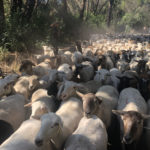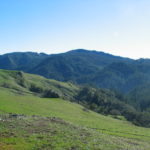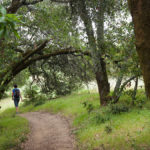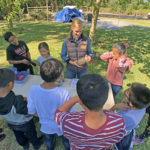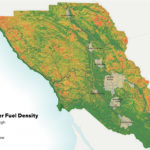January 28, 2020
Posted in: News Articles
Our conservation work in 2019: A year in review
As 2020 gets underway, we wanted to reflect on 2019 – a year where our community once again experienced flood and wildfire. And once again, our staff supported the emergency response to both disasters, and will continue to work with landowners affected by the Kincade Fire to aid in their recovery. Looking ahead in 2020, we’re excited to finalize our Vital Lands Initiative, which will serve as our conservation roadmap for the next 10 years. We are, as always, grateful for our partners and the local community for making this work possible.
We invite you to take a moment to review some of our accomplishments of 2019:
- Transferred the 153-acre Healdsburg Ridge Open Space Preserve to the City of Healdsburg. This Open Space Preserve is located along a prominent ridgeline on the northeastern edge of the city of Healdsburg. Visitors to preserve get to experience natural open lands with views of the Russian River right on the urban edge. As part of the transfer, we retained a conservation easement that will protect a diversity of habitats, and a recreation covenant to ensure the preserve on the edge of Healdsburg remains open to the public, forever!
- Acquired conservation easements on the collective 1206 acres that make up Weeks Ranch North and Weeks Ranch South. These lands are home to rolling grasslands, Douglas-fir forest, and cattle grazing, in addition to containing the headwaters of tributaries to Santa Rosa and Mark West creeks.
- We also received approval from our Board of Directors to acquire a conservation easement over Jacobson Ranch – a nearly 127-acre property, made possible by the generous current owners, Walt and Arleen Jacobson. The property acts as a greenbelt along the west-side of Petaluma and the easement includes provisions for continued grazing, while also allowing for the possibility of growing food crops. Protection of Jacobsen Ranch helps to ensure Sonoma County’s unique character and agricultural heritage.
- In December, we shared our current draft for the Vital Lands Initiative during a public workshop with our Board of Directors. The Vital Lands Initiative maps out our work for the next decade, and will be presented to our Board of Directors for final approval this spring.
- In the face of increasing climate change, we are helping to make our natural and human communities more resilient to extreme events such as wildfires, floods, and drought. One example of this is our fire resiliency work with the Sonoma Valley Wildlands Collaborative to procure a $1 million CAL FIRE grant to undertake fuel reduction work, such as controlled burns, targeting thinning and reduction of ladder fuels, installation of shaded fuel breaks, and vegetation clearing on the collective lands in Sonoma Valley that are managed all partners that have formed collaborative.
- We also worked with Sweetgrass Grazing Company to remove invasive yellow star thistle and reduce fire fuel loads at Calabazas Creek Open Space Preserve by allowing several hundred sheep to graze roughly 50 acres of grassland.
- In 2019, we also finalized a countywide map of fire impacts using pre- and post-fire imagery captured using a $90,000 grant from NASA, and developed a Fire Story Map from this information.
- When the Kincade Fire hit in October, Ag + Open Space staff played an integral role in helping the County respond to the emergency. As we turn to recovery and the long-term resiliency of our entire community, we continue to focus on the conservation and ongoing stewardship of our natural and working lands. Approximately 14,000 acres of Ag + Open Space-protected lands were directly affected by the fires. In addition to reaching out to easement landowners to offer support and share resources, Ag + Open Space staff visited protected properties in the burned areas to assess damages.
- One of the priorities in our draft Vital Lands Initiative is the protection of stream corridors – for their ecological values as well as their important role in groundwater recharge and flood resiliency. In partnership with the Sonoma and Gold Ridge Resource Conservation Districts, we were awarded a $98,000 grant from the California Department of Conservation, to support the development of a detailed outreach and implementation plan to increase the number of high priority riparian corridors and agricultural lands protected by Ag + Open Space. This work will include the development of new conservation tools, as well as documentation of the multi-benefit outcomes of conserving our natural lands.
- Our Board of Directors approved a management plan for the 960-acre Saddle Mountain Open Space Preserve to ensure the continued health of this land, including plans for addressing threats like soil erosion, invasive species, and how to manage potential fire fuel loads.
- Our Board of Directors adopted new Matching Grant Program Guidelines in preparation for the 2020 funding cycle to improve transparency in the evaluation criteria and review process. Public workshops for the new round of program applicants are being hosted in January and February of 2020. Every other year, Ag + Open Space, through our competitive Matching Grant Program, provides funding to public agencies and nonprofits for the protection of open spaces within Sonoma County communities for local agriculture, community recreation, natural resource restoration, and public access.
- Provided grant funding to acquire and open Graton’s first and only downtown public park, the .5-acre Graton Green, through our Matching Grant Program. In partnership with the Graton Green Group, a local nonprofit, the development of this park includes provisions that will protect the land and allow for public access to this community open space forever.
- Through our Public Outings + Youth Education program, we hosted over 4,100 Sonoma County community members on outings, field trips, and other educational experiences on protected lands.
